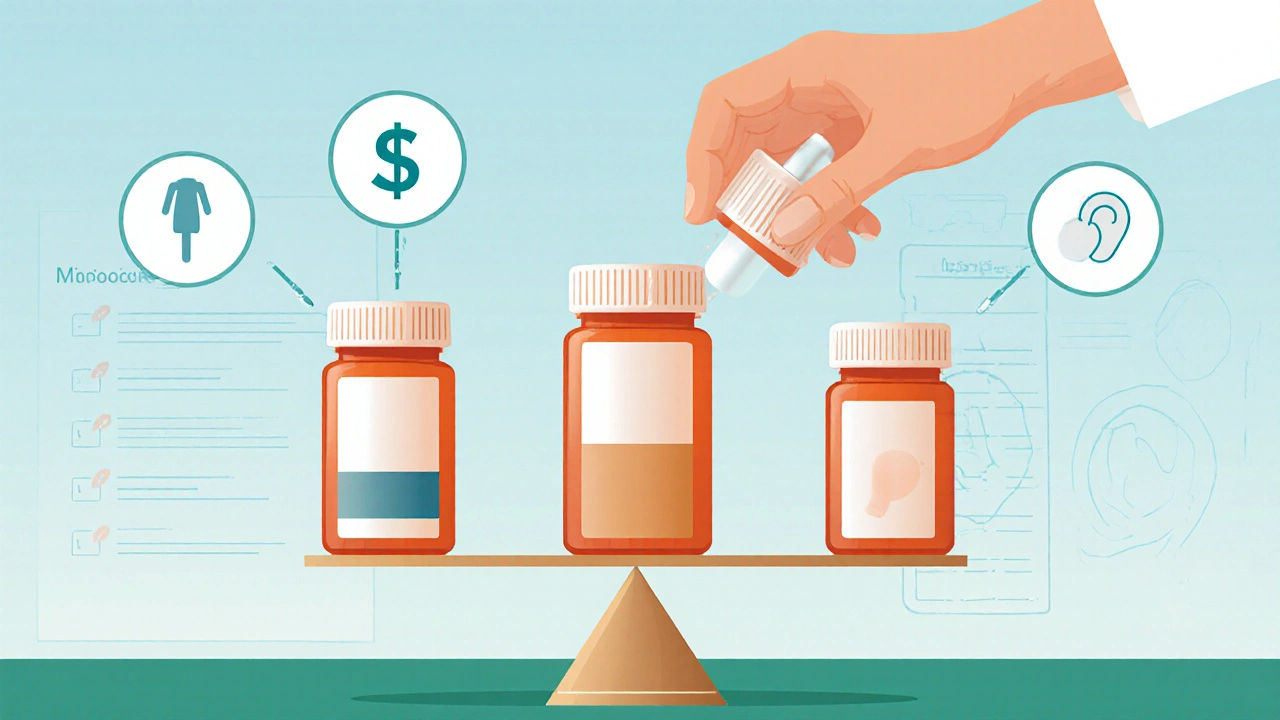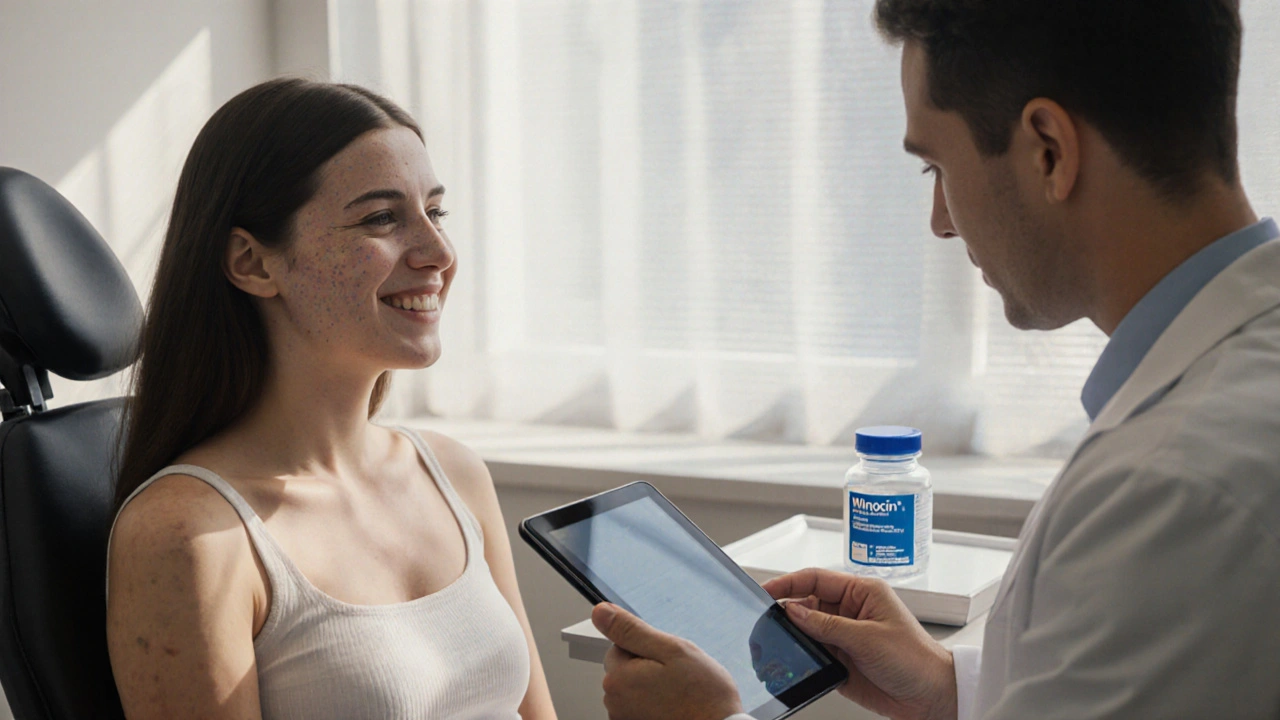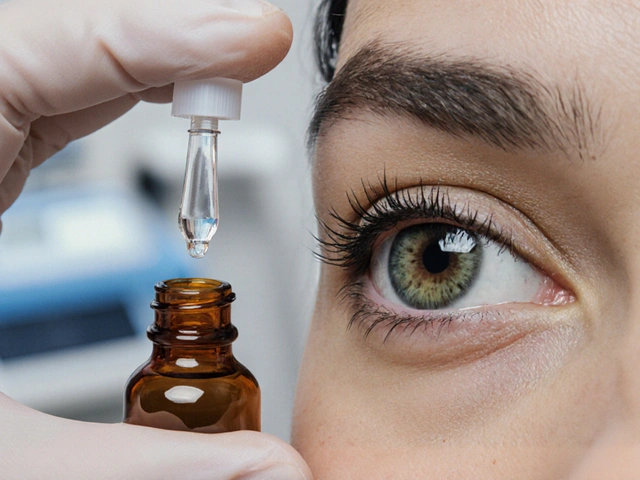Antibiotic Alternative Calculator
Your Situation
Recommended Alternatives
Key Decision Factors
| Factor | Minocin | Best Alternative |
|---|---|---|
| Cost (Monthly) | $120 | |
| Side Effects | Pigmentation, dizziness | |
| Dosing Frequency | Once daily |
When doctors talk about Minocin (minocycline) is a broad‑spectrum tetracycline antibiotic used primarily for moderate to severe acne and certain bacterial infections.
Key Takeaways
- Minocin is effective for acne but can cause pigment changes and vestibular side effects.
- Common alternatives include doxycycline, tetracycline, azithromycin, clindamycin and erythromycin.
- Decision factors: drug class, dosing convenience, cost, safety profile, and specific infection type.
- Switching drugs should be done under medical supervision to avoid resistance and adverse reactions.
- Minocin alternatives often cost less and have fewer cosmetic side effects, but may require longer treatment durations.
How Minocin Works
Minocin belongs to the tetracycline family. It binds to the 30S ribosomal subunit of bacteria, blocking protein synthesis. Because it penetrates skin pores well, it reduces Propionibacterium acnes (now Cutibacterium acnes) counts and dampens inflammation. Its half‑life of roughly 16hours allows once‑daily dosing for most adults.
When Patients Look for Alternatives
Several real‑world triggers push patients to consider a switch:
- Visible discoloration of teeth or skin after several weeks of therapy.
- Persistent dizziness, vertigo, or tinnitus.
- Pregnancy or plans to become pregnant (Minocin is Category D).
- Insurance formularies that favor cheaper options.
- Allergic reactions or severe photosensitivity.
In these cases, clinicians evaluate the infection type, severity, and patient preferences before picking an alternative.

Top Oral and Topical Alternatives
The most frequently prescribed substitutes fall into three groups: other tetracyclines, macrolides, and lincosamides. Below is a snapshot of each.
| Drug | Class | Typical Acne Dose | Half‑Life | Average Monthly Cost (US$) | Key Side Effects |
|---|---|---|---|---|---|
| Minocin | Tetracycline | 100mg once daily | ~16h | ≈$120 | Pigmentation, vestibular issues, photosensitivity |
| Doxycycline | Tetracycline | 100mg once or twice daily | ~18h | ≈$45 | Gastro‑intestinal upset, photosensitivity, yeast overgrowth |
| Tetracycline | Tetracycline | 500mg four times daily | ~8h | ≈$30 | Frequent GI irritation, photosensitivity |
| Azithromycin | Macrolide | 500mg once daily for 3weeks, then 250mg daily | ~68h | ≈$70 | GI upset, QT prolongation (rare) |
| Clindamycin | Lincosamide (topical) | 1% gel or solution applied BID | ~2.5h (systemic); topical effect lasts 12h | ≈$35 | C.difficile infection risk, mild skin irritation |
| Erythromycin | Macrolide | 250mg four times daily | ~1.5h | ≈$40 | GI upset, hepatic enzyme induction |
Decision Criteria - What Matters Most
Not every alternative fits every patient. Use the following checklist to narrow the field:
- Infection type: For severe cystic acne, a potent oral tetracycline (Minocin or doxycycline) usually outperforms macrolides.
- Pregnancy status: Doxycycline and Minocin are contraindicated; azithromycin and erythromycin are safer.
- Cost tolerance: Doxycycline and generic tetracycline are the most budget‑friendly.
- Side‑effect profile: If a patient worries about skin discoloration, avoid Minocin.
- Convenience: Azithromycin’s long half‑life permits fewer pills.
How to Switch Safely
Changing antibiotics isn’t a “stop‑and‑go” process. Follow these steps to reduce resistance risk:
- Consult a prescriber before discontinuing Minocin.
- Complete the current course unless severe adverse events demand immediate stop.
- If switching to doxycycline, maintain a 48‑hour washout period only if the new drug has a different mechanism (most clinicians overlap for 1‑2 days to keep bacterial coverage).
- Monitor for new side effects during the first two weeks of the new regimen.
- Schedule a follow‑up visit or tele‑check to assess acne response.

Real‑World Patient Stories
Case1: Sarah, 24, started Minocin for nodular acne. After 8weeks she noticed a gray‑blue tint on her upper gums. Her dermatologist switched her to doxycycline 100mg daily. Within 4weeks the discoloration faded, and her lesions improved similarly.
Case2: Mark, 32, was prescribed Minocin but reported persistent dizziness. Lab work ruled out vestibular disease. He was moved to azithromycin 500mg daily for three weeks, which eliminated the dizziness and cleared his inflammatory lesions.
Bottom Line - Picking the Right Tool for the Job
Minocin remains a powerful option for tough acne, but its cosmetic and vestibular side effects push many patients toward doxycycline or azithromycin. Cost‑sensitive users often gravitate to generic tetracycline, accepting a more cumbersome dosing schedule. For pregnant or nursing patients, macrolides like azithromycin offer a safer path.
Frequently Asked Questions
What conditions is Minocin prescribed for?
Minocin (minocycline) is FDA‑approved for moderate to severe acne vulgaris, certain respiratory infections, and some tick‑borne illnesses like Lyme disease. Dermatologists often choose it for its deep skin penetration.
How does Minocin differ from doxycycline?
Both are tetracyclines, but Minocin is more lipophilic, giving it stronger skin‑penetration and a higher risk of pigment changes. Doxycycline is less likely to cause discoloration and is generally cheaper, though it may need a twice‑daily schedule for some patients.
Can I take Minocin while pregnant?
Minocin is classified as Pregnancy Category D, meaning there is evidence of risk to the fetus. It should be avoided unless the benefit clearly outweighs the risk and no safer alternative exists.
What are the most common side effects of Minocin?
Common issues include gastrointestinal upset, photosensitivity, and, uniquely, hyperpigmentation of the skin or teeth. Some patients also experience dizziness, vertigo, or tinnitus, especially at higher doses.
When should I consider switching from Minocin to another antibiotic?
Switch if you develop any of the following: noticeable skin or gum discoloration, persistent vestibular symptoms, a new pregnancy, intolerable GI upset, or if your insurance no longer covers the medication. Always discuss the change with your prescriber to choose the best alternative.






I've seen a lot of patients struggling with the discoloration that Minocin can cause, and it's often the tipping point for switching. Most dermatologists start with doxycycline because it offers similar efficacy without the harsh pigment changes. If cost is a concern, generic tetracycline is even cheaper, though you have to take it four times a day. Remember to tell your doctor about any vestibular symptoms like dizziness-they're more common with Minocin. A gradual taper rather than an abrupt stop usually eases the transition.
Honestly, the side‑effects list reads like a horror novel; pigmentation, dizziness, GI upset-what's not to worry about?
Switching to a cheaper alternative beats the anxiety.
From a philosophical standpoint, the decision between Minocin and its alternatives reflects a balance between efficacy and quality of life. One must weigh the tangible benefit of acne clearance against the intangible cost of visual side effects. In many cases, doxycycline provides a middle ground, delivering comparable results at a fraction of the price. It also carries a lower risk of hyperpigmentation, which aligns with a desire for aesthetic constancy. Therefore, the ethical choice often tilts toward the less invasive option.
Yo, if you're dealing with that gray‑blue gum thing from Minocin, ditch it ASAP and hop on doxy. Doxy does the job, costs less, and you don't have to worry about your smile turning weird. Just make sure you talk to ur doc before stopping, but most docs say a 48‑hour overlap is chill. Also, watch out for sun-any tetracycline can make you burn quicker. Keep an eye on any new stuff like weird ear ringing, that's a red flag.
Minocin's side effects are part of a larger pharma conspiracy to keep you hooked 🤔💊
Listen up! Minocin is NOT the only game in town!!! Doxycycline, tetracycline, azithromycin-all viable alternatives!!! Choose wisely!!!
Adding to that, many studies show doxycycline's anti‑inflammatory properties actually help with the deeper lesions that Minocin targets, without the pigment risk. It's a win‑win for patients who want clear skin and a normal complexion.
In my culture, we often prioritize cost over brand names, so the generic tetracycline becomes the default. Yes, dosing is more frequent, but the savings are significant, and most patients adapt after a short adjustment period.
Indeed! Though the four‑times‑daily schedule may seem daunting, the pharmacokinetics of tetracycline ensure steady blood levels, reducing rebound acne flare‑ups dramatically!!